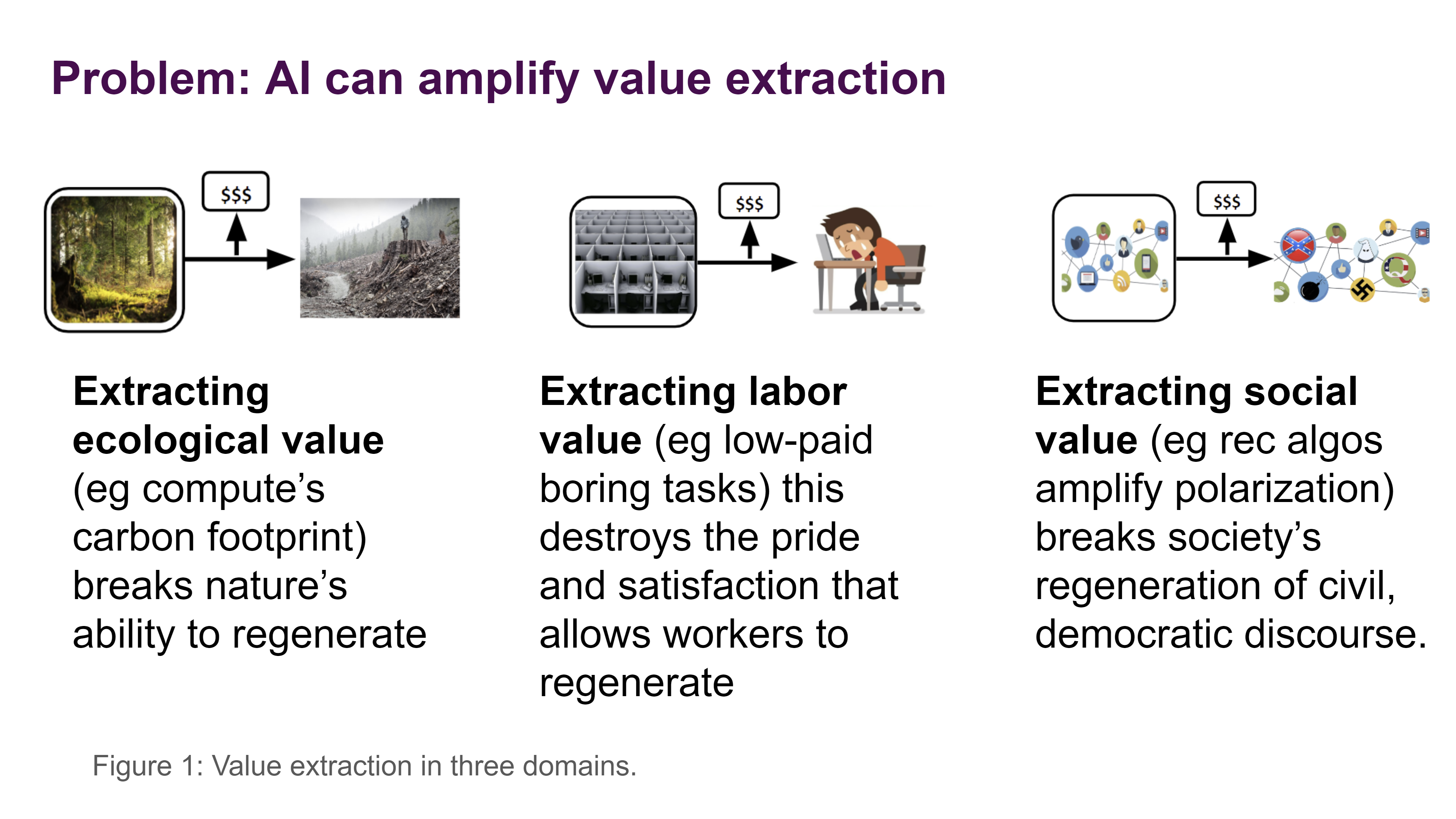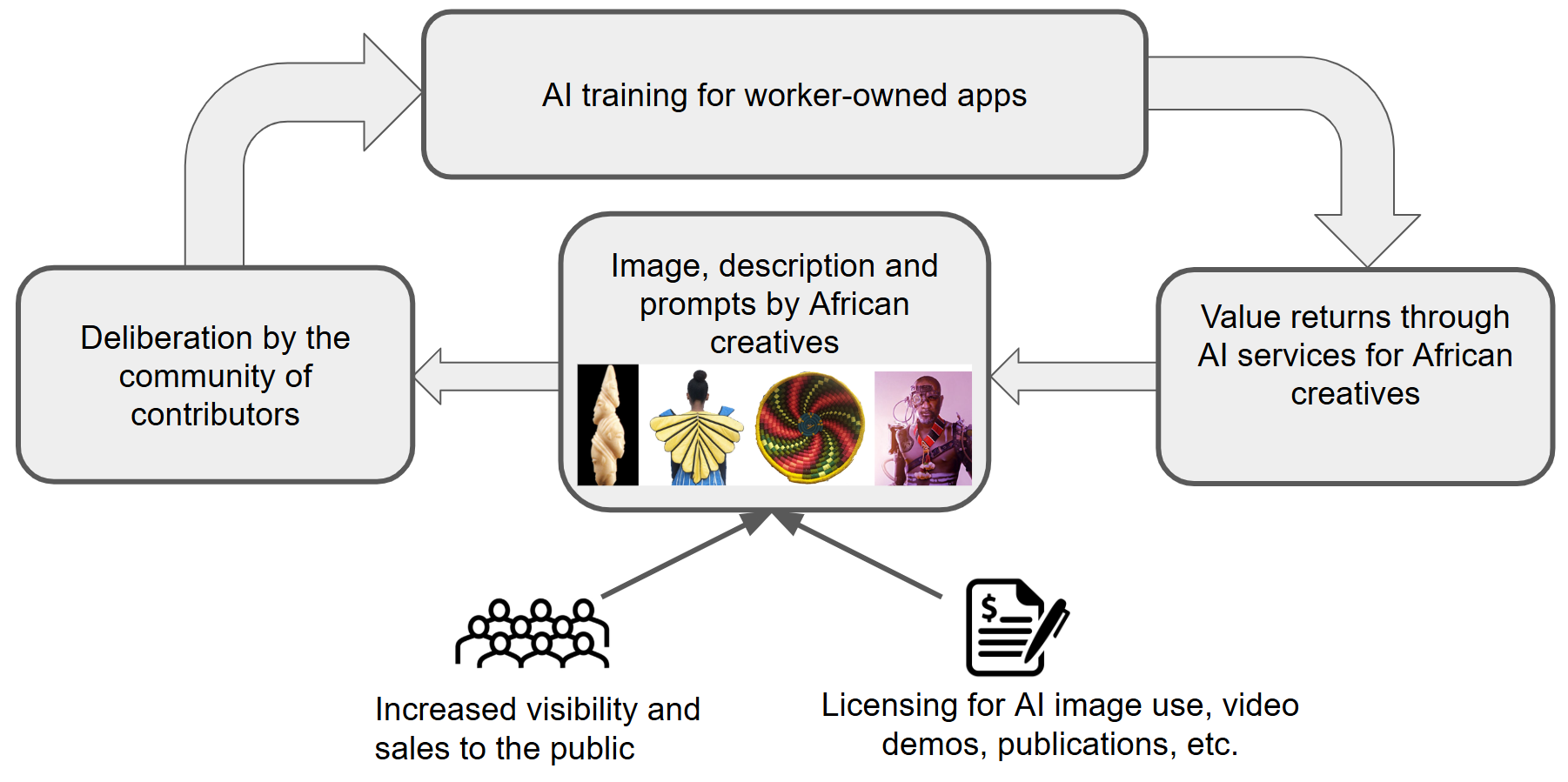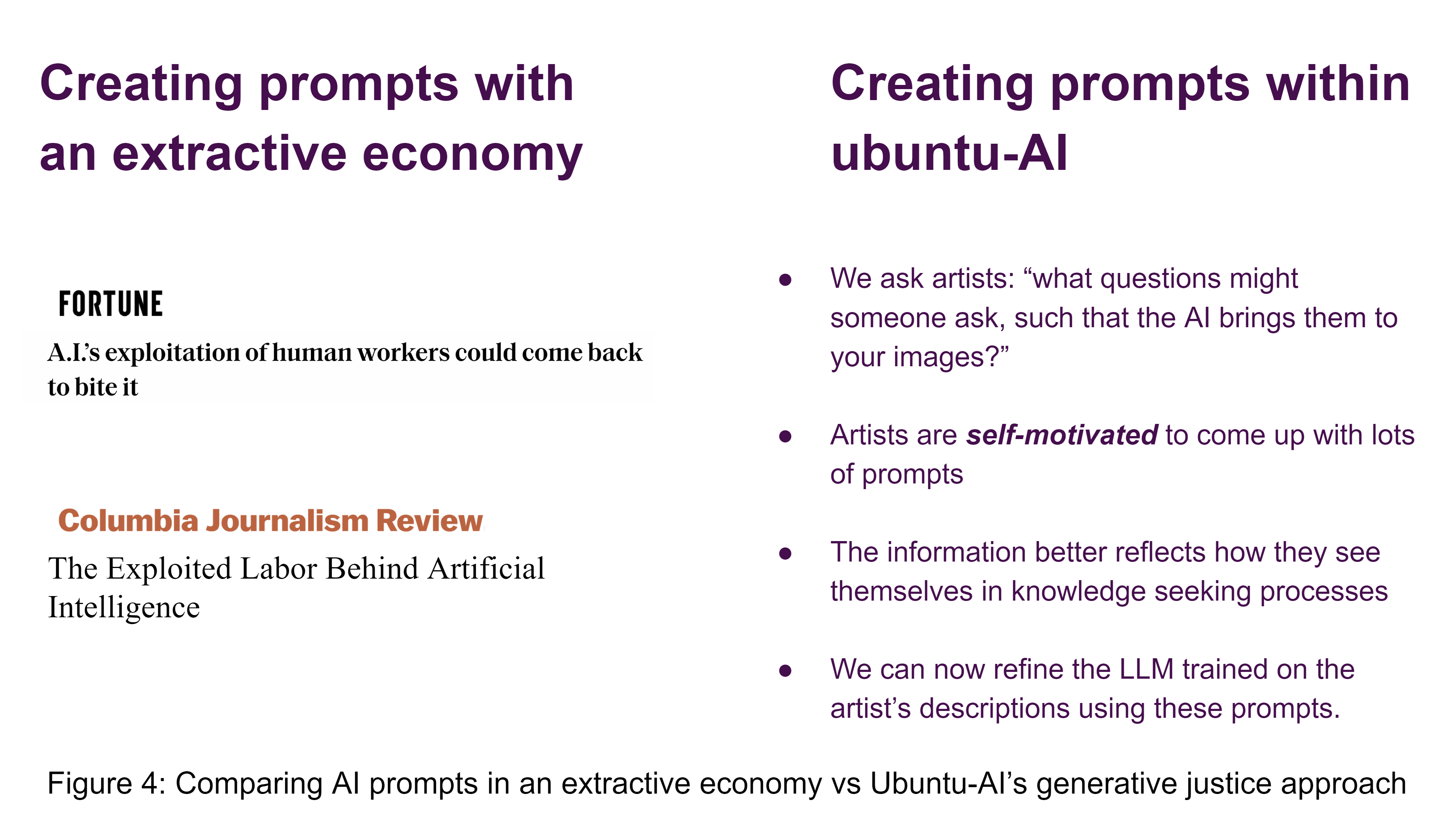Cite as: Nayebare, M., Eglash, R., Kimanuka, U., Baguma, R., Mounsey, J., Maina, C. (2023). “Interim Report for Ubuntu-AI: A Bottom-up Approach to More Democratic and Equitable Training and Outcomes for Machine Learning”. Democratic Inputs for AI, OpenAI Foundation, San Francisco, Sept 29, 2023.
Artificial Intelligence (AI) can be a threat to creative arts and design, taking data and images without permission or compensation. But with AI becoming a global portal for human knowledge access, anyone resisting inclusion in its data inputs will become invisible to its outputs. This is the AI double bind, in which the threat of exclusion forces us to give up any claims of ownership to our creative endeavors. To address such problems, this project develops an experimental platform (https://ubuntu-ai.net/) designed to return value to those who create it, using a case study on African arts and design. If successful, it will allow African creatives to work with AI instead of against it, creating new opportunities for funding, gaining wider dissemination of their work, and creating a database for machine learning that results in more inclusive knowledge of African arts and design for AI outputs.
The challenges created by AI can be understood through the lens of value extraction (figure 1).  Ecosystems normally regenerate, providing sinks for carbon and sources for bioproduction. But industrial scale extraction of that value–clear cutting forests, overwhelming carbon sinks, and so on–breaks nature’s ability to regenerate. Labor in its best form gives us pride in our skills and products, but extracting labor value with low-paid boring tasks exhausts the workers’ ability to regenerate. And communities in their normal state regenerate themselves through civic behaviors and convivial ways of life: thus when social media is designed for extracting our attention, data and mutual respect, it too breaks the kinds of regeneration crucial to a democratic society. The same problem applies equally to both capitalism and communism: whether value is extracted for private corporations or a communist state, the outcomes are equally damaging (Eberstadt, 2017; Eglash, 2018). AI threatens to amplify value extraction in all three domains, from its giant carbon footprint, to its labor issues, to its media acquisition and impacts on society.
Ecosystems normally regenerate, providing sinks for carbon and sources for bioproduction. But industrial scale extraction of that value–clear cutting forests, overwhelming carbon sinks, and so on–breaks nature’s ability to regenerate. Labor in its best form gives us pride in our skills and products, but extracting labor value with low-paid boring tasks exhausts the workers’ ability to regenerate. And communities in their normal state regenerate themselves through civic behaviors and convivial ways of life: thus when social media is designed for extracting our attention, data and mutual respect, it too breaks the kinds of regeneration crucial to a democratic society. The same problem applies equally to both capitalism and communism: whether value is extracted for private corporations or a communist state, the outcomes are equally damaging (Eberstadt, 2017; Eglash, 2018). AI threatens to amplify value extraction in all three domains, from its giant carbon footprint, to its labor issues, to its media acquisition and impacts on society.
But there are many examples of systems that are highly productive, yet do not alienate value. Rather, they circulate value in unalienated forms. In organic agriculture, for example, the left-over plant materials and organic waste is used for composting, which enriches the soil, allowing it to regenerate (figure 2).

In other words, we do not have to create techosocial systems for an extractive economy. It is possible to instead create designs that support a generative economy. Eglash (2016) defines this principle as “generative justice”: The universal right to generate unalienated value and directly participate in its benefits; the rights of value generators to create their own conditions of production; and the rights of communities of value generation to nurture self-sustaining paths for its circulation.
Our research project for OpenAI attempts to apply generative justice to the design of an online platform for machine learning. To do so requires that we break the AI double bind by ensuring that those who generate the value–the media used in training AI–have value returned to them, and that ultimately they have democratic control over the platform itself. We selected African art and design as the particular domain of value creation, for two reasons. First, as the subjects of past colonial injustice, they are due reparations. Second, since economic domination and exploitation continues in contemporary Africa, they are highly susceptible to the AI double bind, threatened by exclusion due to lack of accurate information and attention. For example, we asked an AI-driven website for examples of questions about African art. The examples it provided were almost entirely focused on Africa’s relevance to Europe: “When did Pablo Picasso become influenced by African art? “What was the primitivist art movement?”
Thus our aims are three-fold. First, by crowd-sourcing from African creatives, we obtain a richer, more accurate body of data about art and design in Africa, and thus prevent the exclusion of this information from machine learning. At the same time, by creating a platform that can provide more equitable and democratic approaches to machine learning, we prevent the threat of exclusion from becoming a form of blackmail that forces people to give up their data for free. And finally, by refining this design in real-world testing, we hope to offer a general model of how the principles of generative justice can be applied to any machine learning domain.
Figure 3 shows a graph mapping the data flows in our platform. Note that, like the organic agriculture graph of figure 2, this is a circular or “generative” economy. We call this platform “Ubuntu-AI” (online at https://ubuntu-ai.net/). The term is not original to us; several researchers (Birhane, 2021; Mhlambi, 2020; Robinson et al. 2021) have proposed that the ubuntu principle –often summarized as “I am because we are”–be utilized as a guiding principle for AI. It shares the kind of relational economy envisioned in the generative justice literature (https://generativejustice.wordpress.com/publications/), since “relational” is by definition the opposite of “alienated”.
Figure 3: the flow of value on the ubuntu-ai platform
We start with African creatives–those who work in art, design, fashion, and so on–uploading an image of their work, along with descriptions of their process and purpose. We used the research grant provided by OpenAI to pay them for this participation. So far over $40,000 has been distributed to the artisans.
However that was just to get the system started. Another way this will return value to those contributing these works is the public display of the creative works, and their descriptions. Clicking on an image will allow the public viewer with a link to the site in which they sell the work. For well established artists this might be a gallery, but for low income participants this might be an African Non-Governmental Organizations (NGOs) such as artist associations, groups who work with women crafters, textile guilds, and so on. (We work directly with NGOs in part because if we had individuals contacting us, we would be quickly overwhelmed with the challenge of vetting. It is up to the NGO to have a list of their authentic participants, and to send out the registration invitations).
A third way in which value can be returned to the individual is through licensing. Clicking on a contributor’s work also provides a contact form. A viewer might want to use a form of AI called “Neural Style Transforms”, in which you can provide a picture of Obama (“based”), a painting by Van Gogh (“style”), and get Obama as if he was painted by Van Gogh. So far there has been little attention to licensing these images, but this platform will provide an easy way to that. For example, someone who wants to use African baskets to make futuristic architecture (as we saw in the Black Panther movies) now will have a means to pay an African basket maker for it, because of (rather than in spite of) the involvement of AI.
And of course it need not involve AI. Maybe they want to pay for a high resolution version of the image for a book, or they are looking to pay someone to give a live demo of a weaving technique. Showing the students in your class some kente cloth is nice, but letting them meet the person who created it, and have a discussion with them, is starting to look more like a relational economy (Robinson et al. 2021).
Most recently we have been developing new AI tools to assist artisans in their production process. Our initial protoype is an “upcycling” tool that allows them to input an image of the scraps they are working with, and output a product, enhancing both their set of tools and the environmental sustainability of the value chain.
This brings up the democratic side of the platform. Currently there is just a system for storing comments, and contributors can comment on each other’s work, but we will be soon introducing forums for deeper discussions, and eventually deliberation software so that the ownership and governance can be fully passed on to the contributors. If they decide that they want to add AI-based tools for their own use, this brings the entire process full circle at an even deeper level. Other kinds of “branching out” that might happen is to expand this to include the ecological impacts on the material sources of these traditional crafts, perhaps even contributing to the ability of AI to track environmental threats and potential responses.
Other benefits
As noted above, when we asked AI for examples of questions about African art, the examples it gave showed Africa as merely “inspiration” for Europeans. For that reason we ask the contributors to create questions (“prompts”) that someone might ask AI, in which the answer could lead them to your work. That might be “which plants make the dyes in Ghana’s adinkra” or “How do Nigerians use digital technology in art” or anything involving their expression and work as an African creative. These can then be used to test the LLM based on the collected data, as the “human feedback” part of generative AI. In other words, we hope to bring AI and the public more accurate and diverse information about creative works in Africa, based on the perspectives of African creatives. While human reinforcement in LLM training is notorious for its exploitative labor, this offers a far more equitable model, since it aligns the contributors’ own interests with prompt creation tasks (figure 4).
Finally, we note that this is just a model for one domain. All our code (not the data) is open source, and anyone who wants to create a similar platform in a different domain is welcome to do so. We have already received a request to develop an African American version of the platform, and we are seeking funding for that purpose. We will be reporting on the progress on this project and its variations, by us or others, on our site at https://generativejustice.org.
Citations
Birhane, A. (2021). Algorithmic injustice: a relational ethics approach. Patterns, 2(2).
Eberstadt, N. (2017). The poverty of communism. Routledge.
Eglash, R. “An Introduction to Generative Justice.” Teknokultura 13(2), 369-404: Dec 2016.
Eglash, R. (2018). A Generative Perspective on Engineering: why the destructive force of artifacts is immune to politics. In Engineering a Better Future (pp. 75-88). Springer, Cham.
Mhlambi, S. (2020). From Rationality to Relationality: Ubuntu as an Ethical And Human
Rights Framework for Artificial Intelligence Governance. Carr Center for Human
Rights Policy Discussion Paper Series, 9.
Robinson, K. P., Eglash, R., Bennett, A., Nandakumar, S., & Robert, L. (2021). Authente-Kente: Enabling authentication for artisanal economies with deep learning. AI & SOCIETY, 36(1), 369-379.